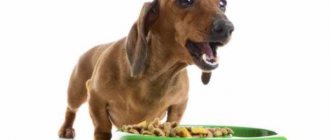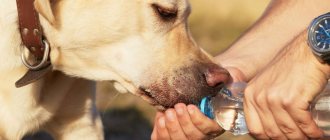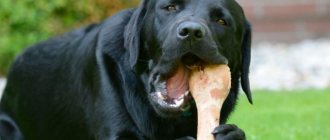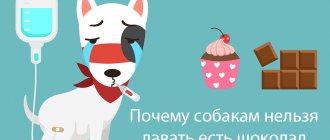The article was finalized and certified
Dubovitsky Yuri Igorevich
Veterinarian
Ask a Question
Dogs cannot tell their owners about health problems using words, and therefore people have to learn to recognize the health status of their pets by their appetite, the quality of their skin and coat, and their level of activity. Any owner should be wary, for example, if the dog has become lethargic, because in most cases this indicates that the animal has serious health problems.
Content
1. Signs of ill health 2. When to worry 3. Other reasons 4. How to help
There can be many signs of an unhealthy dog, they depend on the disease, can be pronounced or appear in the later stages of the disease. The sooner an attentive owner notices that the dog is not behaving as usual and contacts a veterinarian, the greater the chance of keeping the pet healthy. But what to do if the dog does not eat and is lethargic? Why is she refusing to eat and what other signs should you pay attention to?
What to do if your pet becomes lethargic
If your puppy sleeps a lot and is lethargic, but there are no other signs, you can try to normalize his appetite. The second thing to do is to check the animal for parasites and if they are identified, it is necessary to use anthelmintic tablets.
What is prohibited to do
When a pet has lost its appetite and sleeps most of the day, it is strictly forbidden to disturb it while trying to play. It is prohibited to force feed an animal. You cannot wait long without taking any action. Those diseases that can be cured immediately can lead to the death of your pet within a month.
You cannot force your pet to walk
Signs of ill health
A healthy dog has a moist nose, clear eyes, and a good appetite. She is playful and active, runs with pleasure for a walk and meets her owner at the door. But if the dog does not rush to the door, during a walk, after going to the toilet, he strives to get home as quickly as possible, but lies there more than walks, and refuses his favorite treats - this is a reason for serious concern. Refusal of food and water is the first symptom that accompanies most diseases.
Sometimes the cause may be trivial and easily removable, but in some cases, delay in contacting a veterinarian can have irreparable consequences.
And a healthy dog can refuse to eat. In the heat, neither people nor animals want to eat. Therefore, the pet may eat an incomplete portion or refuse food altogether, only drink. There are other physiological reasons why animals lose their appetite. In this case, there are no other alarming signs - increased body temperature, vomiting, diarrhea, convulsions, etc. Changes in the animal’s behavior can be caused by:
- fatigue. Excessive physical activity during training or walking can lead to the dog becoming lethargic and not eating. However, there is nothing to worry about in this case: after resting, the pet is cheerful and cheerful again. Just let him sleep and regain his strength for play;
- stress. Four-legged pets have a vulnerable soul. Many stress factors can cause a refusal to eat: a change of place of residence, a long absence of the owner, long trips, visits to the veterinarian, the appearance of new animals or people in the house. Sometimes even changes in the weather can cause a change in your pet's mood. Then your favorite delicacies do not please you;
- feed quality. Stale or low-quality food can cause indigestion and accompanying vomiting and diarrhea. The animal understands the relationship between its condition and the reasons that caused it, so it refuses to eat. Failure to comply with the feeding regime - handouts from the table, frequent “snacks” can also cause a loss of interest in regular food;
- overeating. Most often, this affects small puppies who do not feel full, so they often suffer from gluttony. This makes them lazy and lethargic. And the absence or lack of physical activity, in turn, increases the risk of developing obesity.
Important!
It is not dangerous for dogs to refuse food for 3-5 days; puppies should not fast for more than 1 day. It is important that the same amount of water consumed is maintained.
Dogs, like people, can feel sad. When left alone for a long time, a dog can become depressed. This is also manifested by a decrease in appetite or a complete refusal to eat. Representatives of some breeds themselves find something to do alone. For example, huskies look for new uses for interior items or play “repair” by carefully tearing wallpaper off the walls. And some, especially small dogs (Chihuahuas, Toy Terriers) can fall into deep depression.
As a dog ages, its motor activity decreases and its behavior changes. The pet lies down more, which also affects its appetite. The body consumes fewer calories and therefore does not require large amounts of food to restore energy. The age at which a dog is considered elderly depends on the breed: large dogs experience old age earlier, while small ones remain active much longer.
Physiological reasons why a dog’s activity decreases, it may eat less than usual, but lie down more, include estrus, pregnancy and the postpartum period. Additional symptoms will indicate this condition. With the onset of pregnancy, the dog becomes lethargic, its nipples swell, and its belly enlarges. In the postpartum period, the female may be apathetic, eat little or refuse to eat.
Important!
A dangerous condition is when a dog refuses water. Dehydration can be fatal, so if your dog is not drinking, you should contact your veterinarian immediately.
Lack of physical activity can cause your dog to consume fewer calories than he gets from his food. The body does not have time to burn them, so the dog does not want to eat, but only drinks. Low physical activity leads to apathy and lethargy.
All these factors do not require medical intervention. By eliminating the causes of depression and loss of appetite, you will get a healthy, active dog with an excellent appetite.
Diagnosis and treatment of possible diseases
If the dog does not eat and is lethargic, this is just a symptom. Full recovery is possible only after diagnosis and selection of an individual treatment plan based on the cause. Veterinarians recommend examination even if physiological factors are suspected.
When making a diagnosis use:
- visual examination and history taking necessary for a complete clinical picture;
- study of general and biochemical analysis of blood and urine, determining changes in basic indicators;
- Ultrasound of the abdominal cavity and x-ray, which helps determine the condition of internal organs and the presence of formations.
If standard research methods do not help, then additional ones are used: biopsy, colonoscopy, bacterial culture and others.
First aid to the victim
With sunstroke
it is necessary to lower body temperature. Move your pet into the shade and wet the belly, outside of the ear, and paw pads with cold water.
If you suspect poisoning, call a doctor and use the following tips before the team arrives:
- Determine the frequency of gagging.
- Assess the color and consistency of the vomit and inspect it for foreign matter.
- Make sure you have enough clean drinking water. If water stimulates new bouts of vomiting, remove it.
- Sweeten your water to raise your glucose levels. If the dog is unable to drink on its own, pour water into it through a syringe without a needle.
- Avoid feeding.
Avoid taking antiemetic drugs. Vomiting is a natural way to cleanse the body of toxins. Blocking it can lead to serious poisoning of the body.
If your pet has lost consciousness
– lay him on his side and open his jaw. This will prevent you from choking on vomit. You can’t wait for a veterinarian in only one case – poisoning in front of your eyes. To remove toxins, the dog must be given a laxative or activated charcoal.
When neutralizing a tick
Be sure to wear protective gloves. The parasite can be pulled out with your fingers or tweezers from a manicure set. Gently grab the tick where it penetrates the skin and unscrew it in a smooth clockwise motion. Avoid sudden movements and vertical stretching. After a successful operation, apply an antiseptic to the bite site. Place the parasite in a jar and take it to a veterinary clinic for diagnosis. Do not give your dog anti-itch medications before visiting the doctor. This will blur the clinical picture and make diagnosis difficult.
When self- treating an external wound
clean it of dirt and foreign objects. Remove damaged skin to prevent it from dying and infecting healthy areas. Rinse the wound under running water and treat with an antiseptic solution. Tighten the edges of the wound and secure with a sterile bandage. If the wound is wide and deep, clamp the vessels with a tourniquet and immediately take the victim to the clinic.
dermatitis is suspected
It is prohibited to treat affected skin or cut hair. Blurring the symptoms will interfere with the correct diagnosis. If you want to help and relieve the itching, give an antihistamine.
Ways to regain appetite
If no pathologies are found, then try to restore your appetite using the following tips
:
- Skip a few feedings. Do not change food or usual products. If the pet is spoiled, then the problem will be solved by a banal feeling of hunger. Remember that giving in to provocations and giving out treats is prohibited.
- Remove food immediately after your dog eats. If you only eat a few grains of food, don’t worry. Not having a constant source of food will only whet your appetite.
- Treat your dog to fish. 10 minutes before feeding, feed your pet a small piece of lightly salted fish. Salt increases the production of gastric juice and stimulates hunger. Do not make this trick permanent and be sure to consult your veterinarian. Salty food is harmful to four-legged pets. In the presence of chronic diseases, even a small amount can cause a relapse.
- Increase the frequency and total time of walking. This will help work up an appetite. If your dog is not eating well and is lethargic, active walks will cheer him up.
- Change your diet. Change your usual cereal, type of meat or offal. Too monotonous food quickly gets boring. Avoid monofeeding.
- Feed food to another animal in front of your picky dog. Animals don't like to share their food, so this trick is very effective.
If the condition does not return to normal within 1-2 weeks, undergo a re-examination. Some diseases are difficult to diagnose in the early stages even with the help of special equipment. The dog does not eat for a long time due to a disease that is not always obvious. Whims and stress do not last long.
Types of therapy
In the treatment of intussusception
surgical intervention is used. This type of intestinal obstruction is accompanied by the blocking of the lumen of one part of the intestine by another. It is impossible to cure the victim solely with medication. After surgery, antibiotics and anti-inflammatory drugs are prescribed.
In addition to intestinal blockage, any disorder in the liver
– hepatocytes.
Their poisoning and destruction occurs under the influence of toxins secreted by parasites or viruses. The likelihood of liver failure and blood poisoning increases. In such cases, the recommended course
:
- hepatoprotectors that restore damaged hepatocytes;
- immunomodulators and vitamins that stimulate the functioning of immune cells;
- antibiotics that destroy the pathogen;
- anti-inflammatory drugs that eliminate inflammatory processes inside the body.
In case of poisoning
it is important to eliminate intoxication, reduce the level of acidity in the stomach, relieve pain spasms and slow down the gag reflex. For severe dehydration, saline drips are prescribed. A dangerous poison that has entered the victim’s body is suppressed by introducing an antidote. Toxins are removed using sorbents and diuretics.
Before treatment for helminthic infestation
it is necessary to determine the type of parasite. Typically, female worms lay eggs near the anus, so stool analysis is used for diagnosis. When infected with helminths, it is important to restore the functionality of the affected organs, remove parasites and minimize possible complications. It is recommended to use anthelmintic suspensions and pastes for puppies, and tablets for adult animals. Due to the risk of infection, the owners must also take an anthelmintic.
Anti-mite therapy
takes from 1 to 2 months. Only the extreme stage of encephalitis cannot be treated. In other cases, the victim is prescribed hepatoprotectors, acaricidal, antihistamines and diuretics. In case of severe intoxication, blood transfusion is recommended. Mandatory sterilization is provided for those who have recovered from demodicosis. The disease is inherited, so such individuals are discarded from breeding.
Speed of recovery from injuries
depends on their severity. The victim is prescribed analgesics and anti-inflammatory drugs. For some bruises, warming with a blue lamp or a warm heating pad is recommended. Scratching the wound is avoided by wearing a special collar.
For animals with cancer
radiation or chemotherapy, a course of antibiotics and immunomodulators are provided. The tumor is removed with a scalpel, laser or freezing. In the final stages, the disease is considered incurable. Euthanasia is recommended.
Treatment of dermatological diseases
carried out at home. Antifungal or antibacterial drugs, corticosteroids and antihistamines are prescribed. If skin problems are caused by an allergic reaction, allergen-specific immunotherapy (ASIT) is recommended. This technique involves injecting a diluted allergen with a gradual increase in its concentration. ASIT develops immunity and reduces the strength of the allergic reaction.
Tartars
eliminated by ultrasonic cleaning. The procedure is performed without anesthesia. Pain relief is allowed for excessive aggression or fear. More complex manipulations involving filling, restoration of a broken tooth or its removal are carried out exclusively under anesthesia. After restoring diseased teeth, dentists recommend regular brushing, dry feeding, and rubber toys that clean the enamel during chewing.
Diet
Regardless of the diagnosis, the animal must be put on a therapeutic diet. A fast is recommended for the first 24 hours. Monitor the amount of clean water. It helps remove toxins. On the second day, gradual introduction of light and liquid food is allowed. The safest dish option is chicken broth. After the vomiting disappears, offer your pet oatmeal or rice porridge. Boil chicken or turkey fillet, add cooked vegetables and fresh herbs.
Feed the patient in small but frequent portions 5-6 times a day. As you feel better, introduce new foods. All food offered must be warm and fresh. If a portion remains uneaten, throw it away and prepare a new one. Returning to the previous diet is acceptable if good health lasts more than 3 days - but not in the case of poisoning and gastrointestinal disorders.
When to worry
Refusal to eat, lethargy and apathy are signs of many diseases. On hot summer days, dogs often overheat in the sun and suffer heatstroke. Hypothermia is no less dangerous. It usually affects dogs of small breeds and animals without fur. In cold, drafty conditions, you may notice that the dog is shaking. Other signs of hypothermia:
- body temperature below +37.5 °C;
- shiver;
- slow breathing;
- convulsions;
- slowing heart rate.
Gastrointestinal pathologies
A dog may be lethargic due to various diseases of the gastrointestinal tract. They are often accompanied by pain and cramps in the abdomen, vomiting, and diarrhea. Eating aggravates the painful condition, provokes a new attack of pain, so the dog tries to move less and refuses to eat. Only a veterinarian can make a diagnosis after examination and a series of examinations. A depressed state and loss of appetite are a reason to contact a veterinary clinic.
Poisoning may have the same symptoms as gastrointestinal diseases. Intoxication can be caused by poor-quality food, medications and toxic substances (rat poison, for example), household chemicals, etc. Yellowing of the eyeballs and dry skin should cause alarm. Poisoning is usually accompanied by an increase in body temperature. Refusal to eat is the first sign of intoxication, which requires contacting a veterinarian.
Viral infections
Another reason why you cannot ignore the behavior of a dog that refuses to eat and lies on the bedding all day is the danger of contracting viral infections. Distemper, viral enteritis and other diseases that can lead to death must be treated immediately. Without qualified medical care, puppies die in 90% of cases.
Other signs that may indicate a viral infectious disease are:
- with distemper - photophobia, fever, ulceration of the mucous membranes, purulent discharge from the eyes, difficulty breathing;
- with parvovirus enteritis - vomiting, loose stools with blood, increased thirst;
- with adenovirus – redness of the mucous membranes, dry cough and wheezing, runny nose, vomiting;
- with viral hepatitis - increased body temperature, severe thirst, diarrhea and vomiting, yellowing of the skin and mucous membranes, keratitis and conjunctivitis.
Important!
In case of infectious diseases, if a pet refuses food and water, dehydration quickly occurs. It can cause the death of the animal.
Methods for normalizing appetite
In cases where the lack of appetite and drowsiness are not caused by pathologies, the pet’s appetite can be normalized by the following measures:
- skipping several meals to make the animal hungry;
- increased strength of physical activity, large breeds, German shepherds, Labradors, need to move more than decorative animals;
- providing long and frequent walks;
- introduction of new products into the diet.
Additional Information! A secret that will help awaken the appetite is to feed your pet a piece of lightly salted fish 10-15 minutes before feeding. This is an effective method to stimulate hunger.
Other reasons
Refusal to eat and the pet’s depressed state are also typical for other diseases. Diseases of muscles, bones, joints, and blood diseases are accompanied by pain. Pain occurs when moving, hence the unsteady gait and lethargy.
Injuries can damage internal organs. Internal bleeding threatens the dog’s life, but it is impossible to detect it visually. If your pet has a fever, is shaking, is vomiting, and there is blood in the vomit, contact your veterinarian immediately. And the best thing is to call a doctor at home, since during transportation there is a risk of further aggravating the problem.
With helminthiasis, a dog may experience bloating and bloody clots in the stool. The weakness and lethargy of the dog is explained by intoxication of the body - worms poison it with the products of their vital activity. Therefore, the pet is sad and refuses its favorite games and treats.
If your pet not only eats poorly and tries to lie down more, but at the same time he suddenly loses weight, it is worth checking him for cancer. In recent years, cancer has often been diagnosed not only in older animals, but also in young ones. The prognosis for the development of the disease and the quality of life of the animal depends on how quickly the diagnosis is made.
Dangers of not eating and drinking
Exhaustion and dehydration are conditions that are dangerous to the health and life of animals.
They affect the body as follows:
If the reason is related to health, then you need to show the dog to a veterinarian as soon as possible.
What to do if your dog has chills and lethargy
It is perhaps possible to talk about providing effective assistance to a trembling pet who has lost interest in life only in cases where such symptoms are caused by clearly physiological reasons. For example, warming up an animal if it is cold is very simple; just take the pet in your arms, bring it into a warm room or cover it with a blanket. The same measures can help the dog calm down, but if the stress is caused by a prolonged factor (separation from the owner, etc.), you need to try to keep the animal occupied with something interesting. Long walks help in such cases, during which the dog gets the opportunity to escape from “dark thoughts.”
Sedatives such as “Stop-stress”, “Anti-stress”, “Sanal Relax”, etc., used by some owners to stop too strong manifestations of the sexual instinct in their pets, are categorically not recommended by most veterinarians, since such therapy negatively affects the health status of the animal. As a general rule, dogs not used in breeding programs are subject to sterilization, which solves many problems and, by the way, statistically increases the life expectancy of animals.
Also find out why a dog shakes its head and ears and what needs to be done in this case.
All other cases of nervous tremors ideally require diagnosis and treatment prescribed by a veterinarian. In exceptional cases, before contacting the clinic, the owner can provide first aid to the pet by using:
- an antihistamine, for example, “Suprastin” or “Desloratadine” - in case of an acute allergic attack;
- sweet water - in case of an obvious attack of hypoglycemia, if the animal has been diagnosed with diabetes mellitus, and the owner has no doubts about the nature of the nervous tremors.











